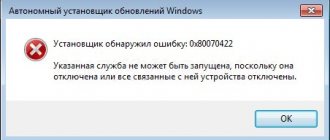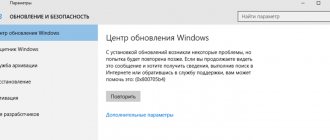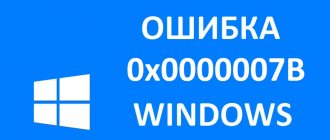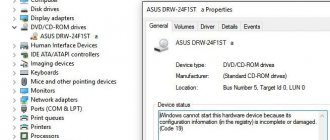Last updated May 16, 2022 at 02:37 pm
Video card error code 43 most often occurs on NVIDIA video cards, but similar problems also occur with AMD Radeon. Typically this message appears: This device has been stopped because it has reported a problem (code43).
It occurs mainly for 2 reasons ⇒
- Driver error
- Hardware problems (physical malfunctions of the device).
Also much less frequently, error 43 can occur when there is a conflict between the video card and RAM.
Naturally, before the error occurred, everything was working fine for you, but some technical or software problems led to its occurrence. We need to identify the potential cause as quickly as possible and start looking for it with the simplest and most likely solutions.
The first thing you need to do is remember what actions you performed on your computer before the error occurred. Maybe you overclocked the RAM, processor, video card. We changed something inside the system unit. Installed a new device or program. In general, everything that could somehow directly or indirectly affect the performance of the computer.
If you did absolutely nothing and error 43 arose on its own, then follow the instructions below.
Description of "Error 43"
If you see a device in Device Manager that is marked with a yellow exclamation point, and in its properties there is a description “Windows has stopped this device because it has reported a problem (Code 43),” first of all, do not worry! This is a typical error that is caused by a hardware malfunction or an error in the device driver.
The error “Windows has stopped this device” or “Code 43” most often occurs in a number of peripheral devices such as Bluetooth or Wi-Fi models, USB hard drives; it is possible that this error occurs in the operation of the video card.
Causes of “Error 43”
As we said above, there are a number of possible reasons for this error, and below we will present the main scenarios for the occurrence of “Error 43” and ways to solve them.
The cause of error code 43 is:
- An error in the device driver is the most common culprit, so trying to solve the problem (unless you probably know the reason) should start from this point;
- A malfunction of the port, connection connector or cable is also a fairly common case due to which Windows OS displays the above error text;
- Lack of power supply to the USB port is a common cause when connecting various devices that consume a lot of energy during operation, for example, portable hard drives, very powerful Wi-Fi adapters, etc.;
- An error in Windows registry settings is a very rare cause of error code 43;
- Damaged OS system files are a very rare cause of error code 43;
Before reading further, try using the simplest advice that you have heard more than once from various support services and system administrators - “Try turning off and then turning on the problematic device or restarting the computer.”
Sound familiar? No matter how trivial it may sound, this is a really working way to solve “Error 43”, and often reconnecting the device or restarting the computer helps get rid of this type of error. After reconnection or reboot, the system initiates reconnection of the device and drivers responsible for its correct operation. So, before you try to look for a potential problem, simply try reconnecting the device or rebooting your computer.
How to solve a problem with a video card driver?
To install the correct software, follow these steps:
- We find on the Internet the latest version of the complete driver package for the necessary equipment. As for video cards, we look for WHQL for NVidia, AMD Catalist Video Card Drivers for Radeon, and so on. Download the software to your computer.
- Uninstall the incorrect driver and all additional utilities included in the kit (for example, NVIDIA Control Panel or AMD Catalyst Software). To do this, it is better to use the “Uninstall a Program Wizard” in the “Control Panel”.
- Clearing the registry. The CCLeaner program is best suited for this - it is easy to use and quite effective.
- We reboot the computer.
- We install new drivers and related utilities, then reboot the computer again.
Device driver error (very common)
The most common and common cause of “Error 43” is a conflict of installed drivers or an error that occurred during the installation / update of drivers. Solutions:
Solution 1: Update the device driver
You need to go to Device Manager and find the problematic hardware. Windows operating systems mark all devices with malfunctions or errors with a yellow exclamation mark.
By right-clicking the mouse, open the context menu of the device and select “Update driver”.
You will be greeted with the Driver Update menu.
Select “Automatically search for updated drivers.” In this case, Windows will automatically search for drivers on the Internet and, based on the search result, will automatically install/update the driver for the problematic equipment.
If you have a downloaded archive with a device driver, you need to extract it to a directory convenient for you and, at the stage of choosing a method for searching for drivers, use the “Search for drivers on this computer” item.
Solution 2: Removing the device
You need to go to “Device Manager” and go to the properties of the problematic equipment.
Open the “Driver” tab.
Click the “Remove device” button.
After the device removal procedure is completed, you need to turn off the computer and disconnect the problematic equipment that has encountered an error.
You should disconnect the device if an error occurs when connecting USB devices. If “Error 43” occurs on the video card, it is not necessary to remove it. As an exception, you can conduct a visual inspection of the connection elements on the video card and motherboard connector, which can also be the cause of “Error 43” and are described in our next paragraph.
After the hardware is disabled, you need to turn on the computer and reconnect the device, followed by a complete reinstallation of the device drivers.
Connection check and prevention
Turn off your computer from the network and check if the video card is connected correctly. It should fit tightly into the PCI-Express slot and be secured with bolts. It should not wobble or walk along the connector, otherwise, when connecting the cable from the monitor, the card will move in the slot, which will cause image distortion, artifacts and other problems. Additional power must also be connected.
It also wouldn’t hurt to clean the motherboard and video card from dust and dirt. Do not forget to additionally blow out the PCI-Express slot from dust particles. If necessary, replace the thermal paste, especially important if overheating is noticed. In general, it is better to do this regularly, at least 1-2 times a year.
Malfunction of the port, connector or cable (common)
Another common option for the appearance of “Error 43” can be caused by mechanical damage to the connection port on the motherboard, the connector of the connected device (or the cable used for connection).
Mechanical damage to the connection port can occur due to careless installation or dismantling of the equipment, as well as due to mechanical wear due to use. Visually manifests itself as a defect in the contact pair or contact tracks at the point where the device is connected.
Solution
A visual inspection of the connection connector should be carried out. If during the inspection you see problem areas (bent or broken contact tracks, cracks in the PCB, etc.), you should switch the device to another non-defective connector on the motherboard. Alternatively, try to restore or repair the contact fault manually (the editors of sysadmin.ru strongly recommend using a specialized service center if you are not confident in your abilities and a clear understanding of the repair process), for example, using tweezers or a thin needle.
The lack of contact on one connection element may be an obvious cause of an error in the correct operation of the device and the occurrence of “Error 43”.
If these problems are present on the connected device, things are a little more complicated. You will need to contact the appropriate service center to repair the faulty equipment or take advantage of the equipment warranty.
Often large retailers, such as DNS or M.Video, make concessions and are ready to carry out warranty repairs for such a defective device or equipment.
Video card overheating
If error “code 43” was a consequence of incorrect operation of the program, then it will disappear. If the reason is different, and the problem remains, then perhaps the issue is the video card overheating. You can verify this only by disassembling the chip. If the thermal paste has dried out, it means it has not been changed for a long time. You can carefully apply a layer of thermal paste yourself or seek help from a specialized service technician src=»https://nastroyvse.ru/wp-content/uploads/2017/05/nanesenie-termopasti-na-videokartu.jpg» class=»aligncenter "width="1000″ height="576″[/img]
If the “Code 43” error pops up again, then most likely the equipment was operated in extreme conditions for too long, resulting in physical damage. If this video card is very dear to us, then we can try to revive it at a service center. There your video chip will be subjected to heat treatment and it may work if the damage was minor. True, most likely, the masters will charge a high price for such services. Think about whether the game is worth the candle. Perhaps you should just buy a new video card and save yourself the headache?
Lack of power on the USB port (rare)
A less common, but still common cause of “Error 43” may be caused by a lack of power to the device connected to the computer’s USB connector.
As you know, any device connected via USB requires power to operate correctly. For USB 2.0, the permissible maximum power consumption of the device is 0.5 A at 5 V, and in USB 3.0 the maximum current is increased to 0.9 A at the same voltage.
It is worth noting that often extension cords or adapters can cause a similar problem of lack of voltage. In some cases, when using a long cable or a “Chinese” adapter-splitter, the computer is unable to correctly read the information of the connected device, or the power supply to the USB port may be attenuated on particularly long cables.
Solution 1: Change port/cable
To begin with, you should exclude all extension cords and splitters from the device connection diagram and reconnect the device directly to the USB connector of the computer motherboard. You should also take into account the fact that some devices require a USB 3.0 connection by default and will not work correctly in USB 1.0-1.1 and 2.0 connectors due to lack of power supply to the connector.
Solution 2: Disable Device Power Saver mode
Another possible fault vector could be the device switching to the “Energy Saving” mode and its subsequent exit from this mode. Power Saver mode is enabled for all USB devices by default in Windows settings. Due to the specific nature of the operation of the operating system and its energy-consuming elements, the developers decided, after a period of inactivity, to limit the power supply to all peripheral devices in order to generally reduce the computer’s power consumption.
You need to go to “Device Manager” and go to the properties of the USB device.
Go to the “Power Management” tab.
Uncheck the “Allow the computer to turn off this device to save energy” checkbox.
This add-on only works for a specific device, and if you want to disable power restriction for several devices, you should repeat this step for each individual device.
Error in Windows registry settings (very rare)
The Windows registry is a hierarchical database that contains all the parameters and settings of the operating system. It contains all the information and settings for hardware and software, user profiles, preinstallations and various OS settings, file associations, system policies, a list of installed software recorded in the registry, etc.
Solution
We strongly do not recommend that you manually configure or clean the Windows registry, especially without a clear understanding of the actions being performed and the possible consequences!
To optimize the registry, there are specialized programs like Reg Organizer or CCleaner, which will safely remove unnecessary entries and optimize the Windows registry.
Be sure to back up your registry before starting the cleaning and optimization process! They do not take up much space and will help restore the OS in unexpected cases!
A detailed example of cleaning and optimizing the registry is described in the article “How to clean your computer of junk and speed up its operation”
Damaged OS system files (very rare)
Another reason for the appearance of “Error 43” may be damage to OS system files. This mainly happens when the OS installs a major update package and an error occurs that can affect both the operation of device drivers and the operation of the OS as a whole.
Solution 1: System File Check (SFC)
First, you should carry out a procedure to check the integrity of the OS system files.
To do this, you will need to run Command Prompt as an administrator.
In the command line, type the command - sfc /scannow
In response to the command, you will receive a message: “System scanning has started. This process may take some time."
The integrity of system files will be checked.
At the end of the test you will see the result.
If no file integrity errors are found, but “Error 43” remains, you can use the “System Restore” utility.
Solution 2: Restoring the OS from a backup
You can learn how to enable or disable system recovery and OS backups from our article “How to enable or disable system recovery in Windows 7 and Windows 10”
Open the “Control Panel”.
Launch the “Recovery” shortcut.
Click “Run System Restore”.
You will be greeted by the “Restore System Files and Settings” tool.
Select the date of the restore point and click “Next”.
You will be greeted by a window to start the OS recovery process. Click “Finish”.
The recovery utility will warn you that the process is irreversible and cannot be interrupted. We agree and wait for the restoration process to complete.
If the “Restore System Files and Settings” tool reports the error that “System protection is disabled,” then, unfortunately, this recovery method is not suitable for you.
Script (Patch) for NVIDIA and AMD Radeon
An alternative option is to use special patches. There are only two of them.
- Owners of Radeon with modified firmware need to install a special patch “ AMD Patcher 1.4.11 ”. Archive link. Run the file “ atikmdag-patcher.exe ”, a search for settings will begin, if they are found, click “ Yes ”. Otherwise, the script needs to be updated.
- There is also a patch for Nvidia owners. Here is a link to the archive (checked, no viruses). Unzip it to any folder and run the “ nvidia-error43-fixer.bat ” file with administrator rights. Compatibility tested with GTX 950 and newer.
Once everything is done, restart your laptop or PC.
What to do if nothing helps and “Error 43” remains?
Despite the abundance of causes and possible solutions to Error 43, everything is often solved by simply reinstalling or updating the drivers for a specific device.
If the methods described above did not help you and “Error 43” remains, try performing a “clean” installation of Windows.
Alternatively, reconnect the problematic device with “Error 43” to another computer to check the functionality of the device itself. If “Error 43” is repeated on another computer, this may indicate a breakdown or failure of the device itself.











